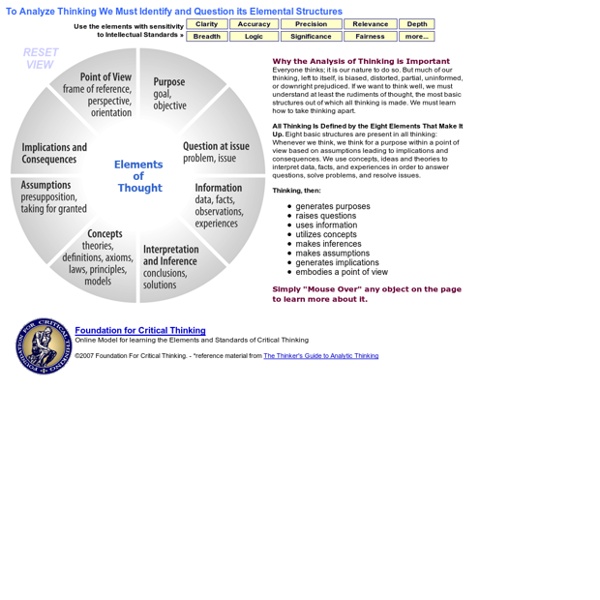Reasoning Resources
While people generally think of an argument as a fight, perhaps involving the hurling of small appliances, this is not the case-at least as the term is used in philosophy. In philosophy, an argument is a set of claims, one of which is supposed to be supported by the others. There are two types of claims in an argument. The first type of claim is the conclusion.
Critical Thinking and Problem-solving
What is Critical Thinking? When examining the vast literature on critical thinking, various definitions of critical thinking emerge. Here are some samples:
Unlocking the Mystery of Critical Thinking
Critical thinking. We all endorse it. We all want our students to do it. And we claim to teach it. But do we?
10 Examples of CT
We all encounter opportunities in our daily lives to engage problems and decisions using strong critical thinking. Everyone needs to think ahead, to plan and to problem solve. Here are ten positive examples of critical thinking:
Deductive and Inductive Arguments
A deductive argument is an argument that is intended by the arguer to be (deductively) valid, that is, to provide a guarantee of the truth of the conclusion provided that the argument's premises (assumptions) are true. This point can be expressed also by saying that, in a deductive argument, the premises are intended to provide such strong support for the conclusion that, if the premises are true, then it would be impossible for the conclusion to be false. An argument in which the premises do succeed in guaranteeing the conclusion is called a (deductively) valid argument. If a valid argument has true premises, then the argument is said to be sound.
Defining Critical Thinking
It entails the examination of those structures or elements of thought implicit in all reasoning: purpose, problem, or question-at-issue; assumptions; concepts; empirical grounding; reasoning leading to conclusions; implications and consequences; objections from alternative viewpoints; and frame of reference. Critical thinking — in being responsive to variable subject matter, issues, and purposes — is incorporated in a family of interwoven modes of thinking, among them: scientific thinking, mathematical thinking, historical thinking, anthropological thinking, economic thinking, moral thinking, and philosophical thinking. Critical thinking can be seen as having two components: 1) a set of information and belief generating and processing skills, and 2) the habit, based on intellectual commitment, of using those skills to guide behavior. Critical thinking varies according to the motivation underlying it.
30 Things You Can Do To Promote Creativity
The concept of teaching creativity has been around for quite some time. Academics such as E. Paul Torrance, dedicated an entire lifetime to the advancement of creativity in education. Torrance faced much opposition in his day about the nature of creativity. Creativity was considered to be an immeasurable, natural ability. Torrance called for explicit teaching of creativity.
A CT Model
To Analyze Thinking We Must Identify and Question its Elemental Structures Standard: Clarityunderstandable, the meaning can be grasped Could you elaborate further? Could you give me an example? Could you illustrate what you mean?
Evaluating Internet Research Sources
Robert Harris Version Date: October 11, 2018 Previous: August 16, 2018, December 12, 2016; January 21, 2015, December 27, 2013; November 6, 2013; Nov. 22, 2010 and June 15, 2007 "The central work of life is interpretation." --Proverb Introduction: The Diversity of Information Adopting a Skeptical (or Cautious) Attitude You might have heard of the term information warfare, the use of information as a weapon.
CERE12-13: Combined student wikis
Deep and Surface Learning: The Literature Tell me, I forget. Show me, I remember. Involve me, I understand. - Confucius
untitled
I said to myself in spring of 2019, after reading through the final papers for a class, “I cannot read another history research paper.” I was done. While some papers rehashed my lectures, others read as if they were amended from a Wikipedia site. Overall, I was frustrated by the (lack of) effort and the redundancy.
The Path to CT
Few of us are effective critical thinkers—who has time? The good news, says Stever Robbins, is that this skill can be learned. by Stever Robbins Can you write a refresher on critical thinking? We business leaders so like to believe that we can think well, but we don't.
Know Your Sources
When doing research you will come across a lot of information from different types of sources. How do you decide which source to use? From tweets to newspaper articles, this tool provides a brief description of each and breaks down 6 factors of what to consider when selecting a source. A platform for millions of very short messages on a variety of topics that enables brief dialogue between distinct groups of people across geographic, political, cultural and economic boundaries. An avenue for sharing both developed and unpolished ideas and interests with a niche community with relative ease.
Instructional or Learning Design
What is known as “sequencing” and organizing “epitomes” in Reigeluth's Elaboration theory, is commonly referred to as “chunking”—configuring large amounts of information into smaller units of information that are scaffolded (supportive structures) in order to accommodate memory and learning limitations. For example, “Instructional Design” is chunked or epitomized into analysis, design, development, Implementation, & evaluation. Developing instruction (Instructional Design) is divided into several theories and a model (at least on this site). Notice how we took a complex subject and chunked it into small, bite size pieces. Charles Reigeluth was a doctorate student of Merrill.



